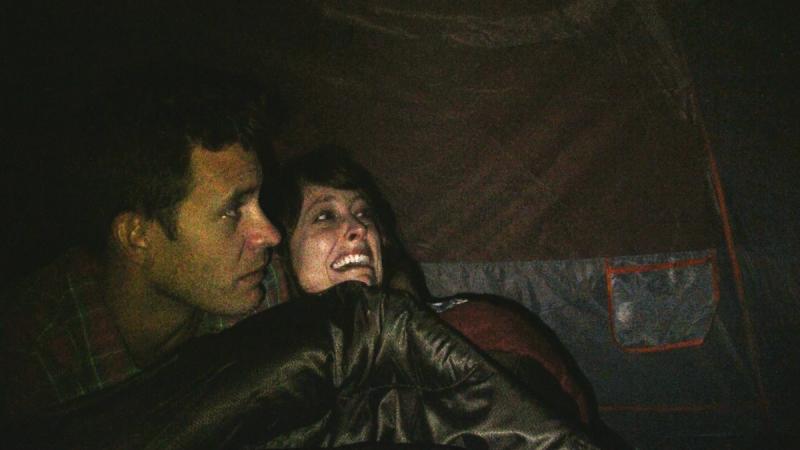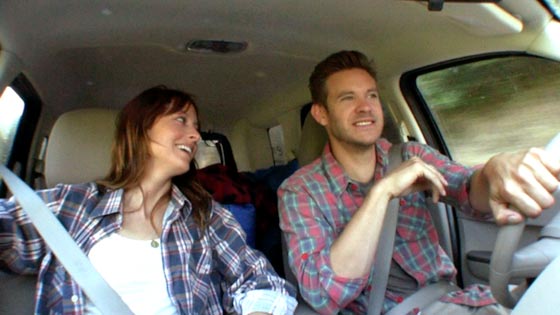Willow Creek | reviews, news & interviews
Willow Creek
Willow Creek
Bobcat Goldthwait finds Bigfoot, in effective, found-footage horror

The Bigfoot legend rests on something close to found-footage: 1967’s grainy film of a large ape-like creature loping through the remote American North-west. The Patterson-Gimlin expedition’s reels are the Sasquatch conspiracy theorists version of the Zapruder footage.
 We are entirely in the company of Jim (Bryce Johnson) and Kelly (Alexie Gilmore), pictured right. He’s a Bigfoot believer since childhood, on a birthday quest to film his trek to Willow Creek, and perhaps stumble on something to support his faith. Seeing Bigfoot is, unwisely, his greatest desire. She’s a happy-go-lucky, loving girlfriend supportively along for the trip, but sceptical about giant ape-men wandering even the 21st century USA’s least charted region undetected.
We are entirely in the company of Jim (Bryce Johnson) and Kelly (Alexie Gilmore), pictured right. He’s a Bigfoot believer since childhood, on a birthday quest to film his trek to Willow Creek, and perhaps stumble on something to support his faith. Seeing Bigfoot is, unwisely, his greatest desire. She’s a happy-go-lucky, loving girlfriend supportively along for the trip, but sceptical about giant ape-men wandering even the 21st century USA’s least charted region undetected.
Goldthwait uses the region to his advantage, training the camera on the Bigfoot statues, trinket shops and bars, and folk-art murals which suggest a secret culture of human-Sasquatch interdependence. History and mythology are indicated for this obscure and otherwise unresonant horror monster, but left unexplained. The eccentric locals Goldthwait left his actors to interview include “the Bob Dylan of Bigfoot songs” and the director himself (pictured below left). Initially known as a helium-voiced loose cannon in the Police Academy franchise, his turn as an unstable Bigfoot bookshop owner is a treat. Another local’s invitation to “have a nice slice of pie at the Fuck Off Café” typifies the pungent dialogue, and the idea of a protected, bad secret outsiders would be well-advised not to find.
 Willow Creek also works as an intimate autobiography of a relationship. Jim’s boyish, increasingly dense, stubborn pressing forward into the wilderness is initially indulged by Kelly. There’s a loose, freewheeling feel to their banter. They are a couple who find each other funny, making them necessarily attractive company, with the camera always on them. That camera, operated by the actors to make the footage appear authentically practical, only becomes an irritant as the expedition unravels, and isolation magnifies Jim’s faults. They remain loving, even under duress, making you feel and fear for them in Willow Creek’s second half, when the outside world falls away, and night descends on the forest.
Willow Creek also works as an intimate autobiography of a relationship. Jim’s boyish, increasingly dense, stubborn pressing forward into the wilderness is initially indulged by Kelly. There’s a loose, freewheeling feel to their banter. They are a couple who find each other funny, making them necessarily attractive company, with the camera always on them. That camera, operated by the actors to make the footage appear authentically practical, only becomes an irritant as the expedition unravels, and isolation magnifies Jim’s faults. They remain loving, even under duress, making you feel and fear for them in Willow Creek’s second half, when the outside world falls away, and night descends on the forest.
The film hinges on a 19-minute night-time take, inside a tent, far out on location. Jim and Kelly are woken by noises and movement outside. Their civilised veneers are scraped away gradually, until Kelly, a realist who fully grasps their helpless position, is consumed by fear. Goldthwait tried three takes, during one of which the actors were too freaked out to continue. This sometimes wandering, boring exercise in real-time fright shows what a self-financed two-hander can do, while revealing nothing except its makers’ expertise in human dread. As Jim thought all along, you don’t have to see Bigfoot to believe in him. He keeps the camera running anyway, for the bloodily brief selfie to end them all.
The future of Arts Journalism
You can stop theartsdesk.com closing!
We urgently need financing to survive. Our fundraising drive has thus far raised £49,000 but we need to reach £100,000 or we will be forced to close. Please contribute here: https://gofund.me/c3f6033d
And if you can forward this information to anyone who might assist, we’d be grateful.

Subscribe to theartsdesk.com
Thank you for continuing to read our work on theartsdesk.com. For unlimited access to every article in its entirety, including our archive of more than 15,000 pieces, we're asking for £5 per month or £40 per year. We feel it's a very good deal, and hope you do too.
To take a subscription now simply click here.
And if you're looking for that extra gift for a friend or family member, why not treat them to a theartsdesk.com gift subscription?
more Film
 London Film Festival 2025 - crime, punishment, pop stars and shrinks
Daniel Craig investigates, Jodie Foster speaks French and Colin Farrell has a gambling habit
London Film Festival 2025 - crime, punishment, pop stars and shrinks
Daniel Craig investigates, Jodie Foster speaks French and Colin Farrell has a gambling habit
 I Swear review - taking stock of Tourette's
A sharp and moving tale of cuss-words and tics
I Swear review - taking stock of Tourette's
A sharp and moving tale of cuss-words and tics
 A House of Dynamite review - the final countdown
Kathryn Bigelow's cautionary tale sets the nuclear clock ticking again
A House of Dynamite review - the final countdown
Kathryn Bigelow's cautionary tale sets the nuclear clock ticking again
 theartsdesk Q&A: Idris Elba on playing a US President faced with a missile crisis in 'A House of Dynamite'
The star talks about Presidential decision-making when millions of lives are imperilled
theartsdesk Q&A: Idris Elba on playing a US President faced with a missile crisis in 'A House of Dynamite'
The star talks about Presidential decision-making when millions of lives are imperilled
 Urchin review - superb homeless drama
Frank Dillane gives a star-making turn in Harris Dickinson’s impressive directorial debut
Urchin review - superb homeless drama
Frank Dillane gives a star-making turn in Harris Dickinson’s impressive directorial debut
 Mr Blake at Your Service review - John Malkovich in unlikely role as an English butler
Weird comedy directed by novelist Gilles Legardinier
Mr Blake at Your Service review - John Malkovich in unlikely role as an English butler
Weird comedy directed by novelist Gilles Legardinier
 Don't Let's Go to the Dogs Tonight review - vivid adaptation of a memoir about a Rhodesian childhood
Embeth Davidtz delivers an impressive directing debut and an exceptional child star
Don't Let's Go to the Dogs Tonight review - vivid adaptation of a memoir about a Rhodesian childhood
Embeth Davidtz delivers an impressive directing debut and an exceptional child star
 One Battle After Another review - Paul Thomas Anderson satirises America's culture wars
Leonardo DiCaprio, Teyana Taylor, and Sean Penn star in a rollercoasting political thriller
One Battle After Another review - Paul Thomas Anderson satirises America's culture wars
Leonardo DiCaprio, Teyana Taylor, and Sean Penn star in a rollercoasting political thriller
 Steve review - educator in crisis
Cillian Murphy excels as a troubled headmaster working with delinquent boys
Steve review - educator in crisis
Cillian Murphy excels as a troubled headmaster working with delinquent boys
 Can I get a Witness? review - time to die before you get old
Ann Marie Fleming directs Sandra Oh in dystopian fantasy that fails to ignite
Can I get a Witness? review - time to die before you get old
Ann Marie Fleming directs Sandra Oh in dystopian fantasy that fails to ignite
 Happyend review - the kids are never alright
In this futuristic blackboard jungle everything is a bit too manicured
Happyend review - the kids are never alright
In this futuristic blackboard jungle everything is a bit too manicured

Add comment